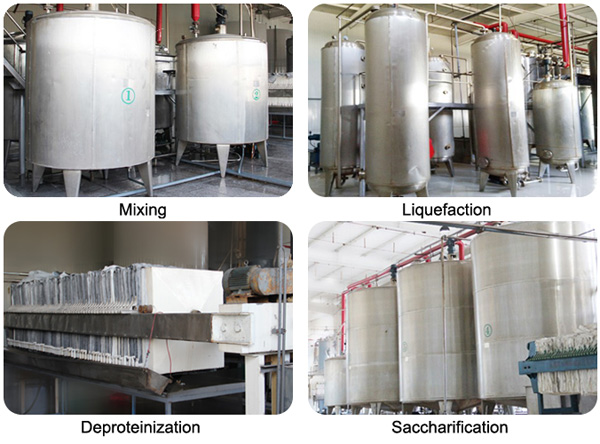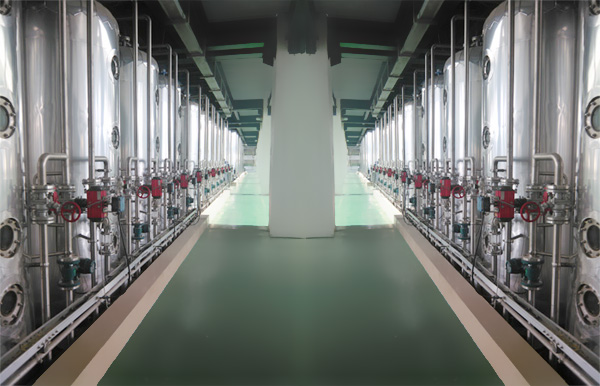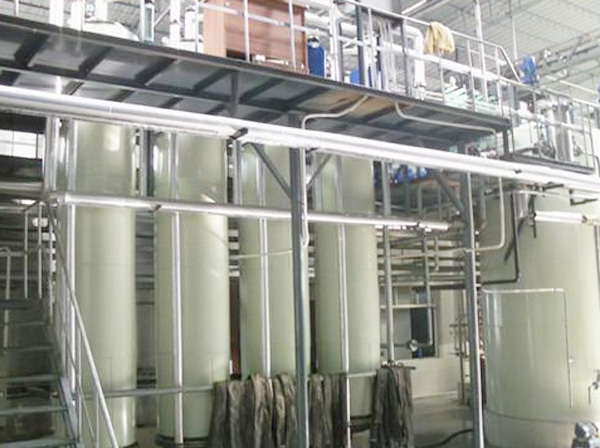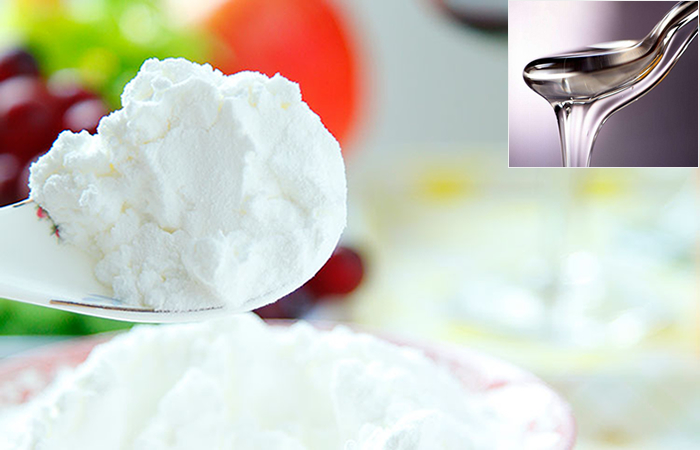High fructose syrup process
2018-08-20 / FAQ
High fructose syrup process: Under the catalysis of glucose isomerase, a part of the glucose solution is converted into fructose, and since its sugar composition is a mixed syrup of fructose and glucose, it is called fructose syrup. The fructose syrup derived from corn starch is called high fructose corn syrup (HFCS), and the fructose syrup obtained from other starches such as rice, cassava, potato, wheat, etc. is called high fructose syrup (HFS). Fructose syrup has type 42 (including fructose 42%), type 55 (55%), and type 90 (90%), which are denoted as F-42, F-55 and F-90, respectively. F-42 fructose syrup is chromatographically separated to obtain syrup F-90 with a fructose content of more than 90%, and mixed with an appropriate amount of F-42 to obtain F-55, next will introduce the high fructose syrup process from starch by Doing Company fructose syrup production machine.

High fructose syrup process from starch
The high fructose syrup process from starch can be divided into four steps: (1) starch liquefaction and saccharification (> 94% glucose syrup); (2) enzymatic isomerization of glucose for fructose; (3) separation of fructose (90%) ; (4) Mix 90% and 42% fructose to obtain the desired level of fructose syrup.
1. Starch liquefaction and saccharification
(1) Pulping and liquefaction. The starch is prepared with water to a starch content of 30% to 35% of dry matter, adjusted to pH 6.0-6.5 with hydrochloric acid, and added per ton of starch raw material for high fructose syrup process. ɑ -amylase dosage 6-10μ / g starch, adding CaCl2 to adjust Ca" concentration of 0.01mol / l. The slurry is pumped into the jet liquefier, instantaneous temperature rise to 105-110 ° C, pipeline liquefaction reaction 10-15min, feed liquid transport To the liquefaction tank, add at a temperature of 95-97 ° C twice. The hydrazine-amylase, continue the liquefaction reaction in high fructose syrup process for 40-60 min, and the iodine color reaction can be qualified.

Liquefaction and saccharification equipment
(2) Saccharification. The starch liquefaction liquid is introduced into the saccharification tank in high fructose syrup process, the temperature is lowered to 60 ° C, the pH is adjusted to 4.5, 80 μg/g glucoamylase is added, the mixture is stirred at 60 ° C for 40-50 h, saccharified to DE>95, and heated to 90 ° C to be saccharified. The enzyme is destroyed and the saccharification reaction is stopped.
(3) Saccharification liquid refining
Continuous filtration using a diatomaceous earth pre-coated drum filter to remove non-soluble impurities and gums from the saccharification solution. Subsequent decolorization with activated carbon. The inorganic salt and organic impurities in the sugar liquid are removed by an ion exchange resin to further increase the purity for high fructose syrup process. The sugar liquid is colorless or light yellow, with a sugar concentration of 24%, a conductivity of < 50 MS/cm, and a pH of 4.5-5.0. It is concentrated by vacuum evaporation to a light transmittance of 90% or more, a DE value of 96-97, and a sugar liquid concentration of 40% to 45% of the optimum concentration required for the isomerase used in high fructose syrup process.

Isomerism process
2. Enzymatically isomerized glucose to fructose
The isomerization process of fructose syrup has a batch process, a continuous stirring method, an enzyme layer filtration method and an immobilized enzyme bed reactor method, and an immobilized enzyme bed reactor method is now widely used. The immobilized enzyme method is to immobilize pure isomerase or cells on a carrier and install it in an upright heat preservation reaction; the purified and deoxygenated glucose solution flows from the top of the column to the enzyme column to cause isomerization reaction. The isomerized syrup flows out from the bottom of the column and the entire high fructose syrup process is continuously operated.
Generally, the sugar liquid passes through the plastic nozzle and uniformly and stably passes through the column from top to bottom, so that the "short circuit" can be avoided, and the sugar liquid is uniformly catalyzed by the enzyme for high fructose syrup process from starch. Flow control is the key, too fast will reduce the fructose content, too slow will affect the yield. In the continuous reaction process, the catalytic activity of the isomerase is high, and the feed amount of sugar is large when starting to use, but the enzyme activity is gradually decreased with the use of a long time, and the feed amount needs to be slowed down to maintain the conversion rate of the product. Constant, the sugar berry sugar content can be maintained at 42%. If only one enzyme column is used in high fructose syrup process, the amount of feed varies greatly. To avoid this disadvantage, several enzyme cartridges are generally used. Using 8 enzyme cartridges, the sugar liquid flux can be kept within 10% of the average value. .

Separation equipment
3. Separation of fructose and glucose during high fructose syrup process
From the fructose syrup containing 42% fructose, the fructose is separated to obtain fructose syrup containing more than 90% fructose, and then mixed with 42% fructose syrup in a ratio of 1:2-3 to obtain 50%. - 60% fructose syrup. Separation of fructose from common fructose syrup is a prerequisite for the manufacture of more than 55% high fructose syrup. A method for separating fructose for high fructose syrup process has been studied, and after comparison, it is recognized by chromatographic separation.

High fructose syrup process from starch
1. Starch liquefaction and saccharification
(1) Pulping and liquefaction. The starch is prepared with water to a starch content of 30% to 35% of dry matter, adjusted to pH 6.0-6.5 with hydrochloric acid, and added per ton of starch raw material for high fructose syrup process. ɑ -amylase dosage 6-10μ / g starch, adding CaCl2 to adjust Ca" concentration of 0.01mol / l. The slurry is pumped into the jet liquefier, instantaneous temperature rise to 105-110 ° C, pipeline liquefaction reaction 10-15min, feed liquid transport To the liquefaction tank, add at a temperature of 95-97 ° C twice. The hydrazine-amylase, continue the liquefaction reaction in high fructose syrup process for 40-60 min, and the iodine color reaction can be qualified.

Liquefaction and saccharification equipment
(2) Saccharification. The starch liquefaction liquid is introduced into the saccharification tank in high fructose syrup process, the temperature is lowered to 60 ° C, the pH is adjusted to 4.5, 80 μg/g glucoamylase is added, the mixture is stirred at 60 ° C for 40-50 h, saccharified to DE>95, and heated to 90 ° C to be saccharified. The enzyme is destroyed and the saccharification reaction is stopped.
(3) Saccharification liquid refining
Continuous filtration using a diatomaceous earth pre-coated drum filter to remove non-soluble impurities and gums from the saccharification solution. Subsequent decolorization with activated carbon. The inorganic salt and organic impurities in the sugar liquid are removed by an ion exchange resin to further increase the purity for high fructose syrup process. The sugar liquid is colorless or light yellow, with a sugar concentration of 24%, a conductivity of < 50 MS/cm, and a pH of 4.5-5.0. It is concentrated by vacuum evaporation to a light transmittance of 90% or more, a DE value of 96-97, and a sugar liquid concentration of 40% to 45% of the optimum concentration required for the isomerase used in high fructose syrup process.

Isomerism process
The isomerization process of fructose syrup has a batch process, a continuous stirring method, an enzyme layer filtration method and an immobilized enzyme bed reactor method, and an immobilized enzyme bed reactor method is now widely used. The immobilized enzyme method is to immobilize pure isomerase or cells on a carrier and install it in an upright heat preservation reaction; the purified and deoxygenated glucose solution flows from the top of the column to the enzyme column to cause isomerization reaction. The isomerized syrup flows out from the bottom of the column and the entire high fructose syrup process is continuously operated.
Generally, the sugar liquid passes through the plastic nozzle and uniformly and stably passes through the column from top to bottom, so that the "short circuit" can be avoided, and the sugar liquid is uniformly catalyzed by the enzyme for high fructose syrup process from starch. Flow control is the key, too fast will reduce the fructose content, too slow will affect the yield. In the continuous reaction process, the catalytic activity of the isomerase is high, and the feed amount of sugar is large when starting to use, but the enzyme activity is gradually decreased with the use of a long time, and the feed amount needs to be slowed down to maintain the conversion rate of the product. Constant, the sugar berry sugar content can be maintained at 42%. If only one enzyme column is used in high fructose syrup process, the amount of feed varies greatly. To avoid this disadvantage, several enzyme cartridges are generally used. Using 8 enzyme cartridges, the sugar liquid flux can be kept within 10% of the average value. .

Separation equipment
From the fructose syrup containing 42% fructose, the fructose is separated to obtain fructose syrup containing more than 90% fructose, and then mixed with 42% fructose syrup in a ratio of 1:2-3 to obtain 50%. - 60% fructose syrup. Separation of fructose from common fructose syrup is a prerequisite for the manufacture of more than 55% high fructose syrup. A method for separating fructose for high fructose syrup process has been studied, and after comparison, it is recognized by chromatographic separation.





